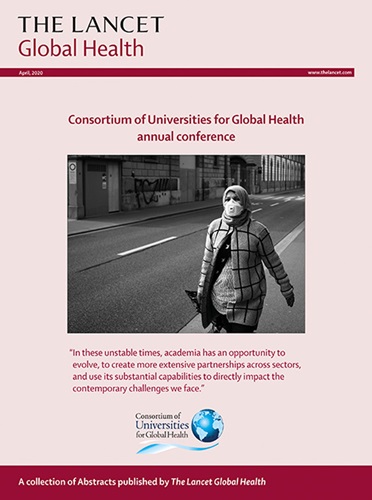用双氢青蒿素-哌喹间歇预防性治疗疟疾对乌干达农村学龄儿童疫苗特异性反应的影响(POPVAC B):双盲随机对照试验。
IF 19.9
1区 医学
Q1 PUBLIC, ENVIRONMENTAL & OCCUPATIONAL HEALTH
引用次数: 0
摘要
背景几种重要的疫苗在不同人群中的免疫原性和功效各不相同。我们假设疟疾会抑制对不相关疫苗的反应,而在高传播环境中每月一次的疟疾间歇预防性治疗 (IPT) 可以逆转这种效应,至少是部分逆转。方法我们在乌干达金贾地区的 9-17 岁学龄儿童中开展了一项个人随机、双盲、安慰剂对照试验,研究疟疾间歇预防性治疗与双氢青蒿素-哌喹对疫苗反应的影响。参与者从两所学校招募,5 岁以后未接触过相关疫苗,但人类乳头瘤病毒 (HPV) 除外。REDCap 采用计算机生成的 1:1 随机分配法。每月服用双氢青蒿素-哌喹 3 天疗程(按体重计算剂量)或安慰剂,包括首次接种前两次。试验参与者在第 0 周接种了肠外卡介苗活疫苗(印度血清研究所,印度浦那)、黄热病疫苗(YF-17D;赛诺菲巴斯德,法国里昂)、伤寒口服活疫苗(Ty21a;第 4 周接种四价病毒样颗粒 HPV 疫苗(默克公司,美国新泽西州拉威市);第 28 周接种类毒素疫苗(破伤风-白喉;印度血清研究所)和 HPV 强化疫苗。14岁以上未接种过疫苗的女性参与者可在第8周再接种一次HPV疫苗,破伤风-白喉强化疫苗则在试验结束后的第52周接种。主要结果是第 8 周时的疫苗反应以及第 52 周时的破伤风-白喉反应,分析是在意向治疗人群中进行的。入学时和随访期间的疟疾寄生虫感染率通过 PCR 进行回顾性测定。安全人群包括所有随机分配的参与者。该试验已在 ISRCTN 注册中心注册(ISRCTN62041885),并已完成。结果在 2021 年 5 月 25 日至 7 月 14 日期间,我们评估了 388 名潜在参与者的资格。我们招募了341名参与者,并将其随机分配到两组(170人[50%]接受双氢青蒿素-哌喹治疗,171人[50%]接受安慰剂治疗);其中192人(56%)为女性,149人(44%)为男性。对双氢青蒿素-哌喹组的 145 名(85%)参与者和安慰剂组的 140 名(82%)参与者进行了随访,直至第 52 周终点。在注册时,双氢青蒿素哌喹组所有参与者中有 109 人(64%)患有疟疾,安慰剂组 170 人中有 99 人(58%)患有疟疾;在所有随访中,双氢青蒿素哌喹组的疟疾发病率降至 6% 或更低。与安慰剂相比,双氢青蒿素哌喹对主要结果没有影响:卡介苗特异性IFNγ ELISpot反应的几何平均比(GMR)为1-09(95% CI 0-93-1-29),P=0-28;黄热病中和抗体为1-19(0-91-1-54),P=0-20(斑块减少中和参考试验(PRNT50)滴度(最后一次血浆稀释减少50%的倒数))和1-24(0-97-1-58),P=0-09(PRNT90滴度(最后一次血浆稀释减少90%的倒数));对肠炎沙门氏菌 O 型脂多糖的 IgG 为 1-09 (0-81-1-46),p=0-58;HPV-16 为 0-72 (0-44-1-77),p=0-19;HPV-18 为 0-71 (0-47-1-09),p=0-11;破伤风类毒素为 1-22 (0-91-1-62),p=0-18;白喉类毒素为 0-97 (0-83-1-13),p=0-72。有证据表明,双氢青蒿素-哌喹减少了黄热病反应的减弱。应进一步探讨对反应减弱可能产生的长期影响。FUNDINGUK Medical Research Council.Translations如需摘要的卢干达文译文,请参阅补充材料部分。本文章由计算机程序翻译,如有差异,请以英文原文为准。
The effect of intermittent preventive treatment for malaria with dihydroartemisinin-piperaquine on vaccine-specific responses among schoolchildren in rural Uganda (POPVAC B): a double-blind, randomised controlled trial.
BACKGROUND
Several important vaccines differ in immunogenicity and efficacy between populations. We hypothesised that malaria suppresses responses to unrelated vaccines and that this effect can be reversed-at least partially-by monthly malaria intermittent preventive treatment (IPT) in high-transmission settings.
METHODS
We conducted an individually randomised, double-blind, placebo-controlled trial of the effect of malaria IPT with dihydroartemisinin-piperaquine on vaccine responses among schoolchildren aged 9-17 years in Jinja district, Uganda. Participants were recruited from two schools and did not have exposure to vaccines of interest after the age of 5 years, with the exception of human papillomavirus (HPV). Computer-generated 1:1 randomisation was implemented in REDCap. 3-day courses of dihydroartemisinin-piperaquine (dosage by weight) or placebo were administered monthly, including twice before the first vaccination. Trial participants were vaccinated with the live parenteral BCG vaccine (Serum Institute of India, Pune, India) at week 0; yellow fever vaccine (YF-17D; Sanofi Pasteur, Lyon, France); live oral typhoid vaccine (Ty21a; PaxVax, London, UK), and quadrivalent virus-like particle HPV vaccine (Merck, Rahway, NJ, USA) at week 4; and toxoid vaccines (tetanus-diphtheria; Serum Institute of India) and an HPV booster at week 28. An additional HPV vaccination at week 8 was provided to female participants older than 14 years who had not previously been vaccinated, and a tetanus-diphtheria booster was given after completion of the trial at week 52. Primary outcomes were vaccine responses at week 8 and, for tetanus-diphtheria, at week 52, and analysis was done in the intention-to-treat population. Malaria parasite prevalence at enrolment and during follow-up was determined retrospectively by PCR. The safety population comprised all randomly allocated participants. The trial was registered at the ISRCTN Registry (ISRCTN62041885) and is complete.
FINDINGS
Between May 25 and July 14, 2021, we assessed 388 potential participants for eligibility. We enrolled and randomly allocated 341 participants to the two groups (170 [50%] to dihydroartemisinin-piperaquine and 171 [50%] to placebo); 192 (56%) were female and 149 (44%) participants were male. 145 (85%) participants in the dihydroartemisinin-piperaquine group and 140 participants (82%) in the placebo group were followed up until the week 52 endpoint. At enrolment, 109 (64%) of all participants in the dihydroartemisinin-piperaquine group and 99 (58%) of 170 participants in the placebo group had malaria; this reduced to 6% or lower at all follow-up visits in the dihydroartemisinin-piperaquine group. There was no effect of dihydroartemisinin-piperaquine versus placebo on primary outcomes: BCG-specific IFNγ ELISpot response had a geometric mean ratio (GMR) of 1·09 (95% CI 0·93-1·29), p=0·28; yellow fever neutralising antibody was 1·19 (0·91-1·54), p=0·20 for plaque reduction neutralising reference tests (PRNT50) titres (the reciprocal of the last plasma dilution that reduced by 50%) and 1·24 (0·97-1·58), p=0·09 for PRNT90 titres (reciprocal of the last plasma dilution that reduced by 90%); and IgG to Salmonella enterica serovar Typhi O-lipopolysaccharide was 1·09 (0·81-1·46), p=0·58, HPV-16 was 0·72 (0·44-1·77), p=0·19, HPV-18 was 0·71 (0·47-1·09), p=0·11; tetanus toxoid was 1·22 (0·91-1·62), p=0·18, and diphtheria toxoid was 0·97 (0·83-1·13), p=0·72. There was some evidence that dihydroartemisinin-piperaquine reduced waning of the yellow fever response.
INTERPRETATION
IPT for malaria with dihydroartemisinin-piperaquine did not improve peak vaccine responses, despite reducing malaria prevalence. Possible longer-term effects on response waning should be further explored.
FUNDING
UK Medical Research Council.
TRANSLATION
For the Luganda translation of the abstract see Supplementary Materials section.
求助全文
通过发布文献求助,成功后即可免费获取论文全文。
去求助
来源期刊

Lancet Global Health
PUBLIC, ENVIRONMENTAL & OCCUPATIONAL HEALTH-
CiteScore
44.10
自引率
1.20%
发文量
763
审稿时长
10 weeks
期刊介绍:
The Lancet Global Health is an online publication that releases monthly open access (subscription-free) issues.Each issue includes original research, commentary, and correspondence.In addition to this, the publication also provides regular blog posts.
The main focus of The Lancet Global Health is on disadvantaged populations, which can include both entire economic regions and marginalized groups within prosperous nations.The publication prefers to cover topics related to reproductive, maternal, neonatal, child, and adolescent health; infectious diseases (including neglected tropical diseases); non-communicable diseases; mental health; the global health workforce; health systems; surgery; and health policy.
 求助内容:
求助内容: 应助结果提醒方式:
应助结果提醒方式:


